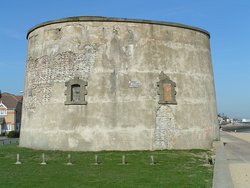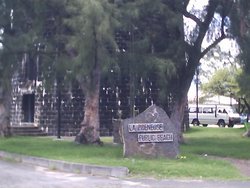Martello tower
|
|
Missing image Martello_tower_500.jpg An aerial view of a Martello tower |
Martello towers are small defensive forts built by the British Empire at the time of the Napoleonic Wars. They stand about 40 feet (12m) high (with two floors) and had a garrison of one officer and 25 men. Their round structure and thick walls of solid masonry made them immensely resistant to cannon fire, while their height made them an ideal platform for a single heavy artillery piece, mounted on the flat roof and able to traverse a 360° arc. A few were surrounded by a moat for extra defence.
They took their inspiration (and their name, albeit mutated) from a round fortress, itself part of a larger Genovese defense system, at Mortella Point in Corsica. This had, in 1794, successfully beaten off the attack of two British warships, 'HMS Fortitude (74 guns) and HMS Juno (32 guns) but was eventually defeated by land-based forces after two days of heavy fighting. The British were duly impressed by the effectiveness of the tower against their most modern warships and copied the design. Between 1804 and 1812 they built a chain of similar structures to defend the south and east coast of England, Ireland and Guernsey to guard against possible invasion from France, as much as the French built similar towers, also used for communication by optical telegraphs (Chappe Telegraph). 105 were built in England, set at intervals along the coast from Seaford, Sussex, to Aldeburgh, Suffolk. Most were constructed under the direction of General William Twiss (1745–1827) and a Captain Ford.
The effectiveness of Martello towers was never actually tested in combat against a Napoleonic invasion fleet. After the Napoleonic threat had passed, England's Martello towers met a variety of fates. Many were taken over by the Coast Guard to aid in the fight against smuggling. Fifteen were demolished to re-use their stonework. Thirty were washed away by the sea, while four more were destroyed by the military in experiments to test the effectiveness of the new rifled artillery. During the Second World War, some Martello towers returned to military service to serve as observation platforms and firing platforms for anti-aircraft artillery. Forty-seven have survived in England, of which a few have been restored and transformed into museums, most are privately owned or private residences and the remainder are derelict.
Martello towers abroad
Martello towers were exported to many colonies of the British Empire, including South Africa (at Simon's Town Naval base near Cape Town), America, Canada, Minorca, the Channel Islands and Ireland. The construction of Martello towers abroad continued until as late as the 1860s, but was discontinued after it became clear that they could not withstand rifled artillery weapons.
One Martello tower, in Mauritius, nearby the La Preneuse public beach in Tamarin, has been restored by the Friends of the Environment and operates as a museum open for visitors. The original entrance to the tower is raised above ground, and a new entrance has been constructed at ground level.
Martello towers dot the Irish coast around Dublin Bay, possibly the most famous of which is the Martello tower in Sandycove, Dun Laoghaire, in which James Joyce lived. Martello towers feature in many literary works based in the city.
A number of Martello towers were built in Canada. One stands on the Plains of Abraham above Quebec City in Canada, overlooking the St Lawrence River. It has been restored as a museum and can be visited. No less than six were built at Kingston, Ontario, as part of the fortifications at Fort Henry, one of which, Murney Tower is now a museum. Carleton Martello Tower, overlooking the harbour of Saint John, New Brunswick, is now a museum and National Historic Site.
The last Martello tower built in the British Empire is said to be that at Fort Dennison, a small island in Sydney Harbour, New South Wales, for the protection of Sydney against possible attack by the Russians during the Crimean War of the 1850s. It is well preserved and a popular tourist attraction.
See also
- Fort Dennison - martello tower fortress in Sydney
- List of castles
- List of fortifications
- List of forts
External links
- Martello Towers homepage (http://www.martello-towers.co.uk/index.html) - a guide to England's Martello towers
- English Heritage Martello towers definition and description (http://www.eng-h.gov.uk/mpp/mcd/mart.htm)
- Carleton Martello Tower National Historic Site of Canada (http://parkscanada.pch.gc.ca/lhn-nhs/nb/carleton/index_e.asp)
- James Joyce Tower, Dun Laoghaire (http://www.visit.ie/countries/ie/dublin/top_at/17_jamesjoycemuseum.htm)
- Fort Denison, Sydney (http://www.ausemade.com.au/nsw/destination/f/fortdenison.htm)de:Genueserturm


